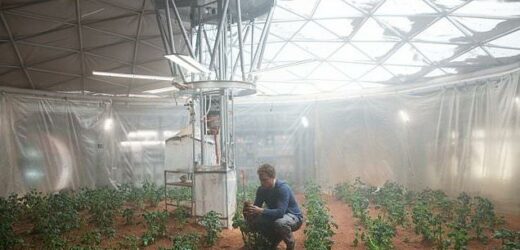Could astronauts grow tomatoes on MARS? Scientists find a new way to grow plants in complete darkness using ‘artificial photosynthesis’
- Scientists have created a new way to grow plants using artificial photosynthesis
- Could lead to innovative methods of growing food on Earth and possibly on Mars
- Photosynthesis enables plants to convert sunlight and CO2 into chemical energy
- But experts say only 1 per cent of the energy found in sunlight ends up in plant
If humankind is to one day make the interplanetary jump from Earth to Mars then the ability to grow plants on the Red Planet will be vital.
Matt Damon found a way in the 2015 blockbuster The Martian, managing to survive on potatoes during the fictional storyline.
Now that vision may may be a little closer to reality, after scientists developed a new method of growing crops in complete darkness using artificial photosynthesis.
Researchers from the University of California, Riverside and University of Delaware used a two-step chemical electrolyser system to convert carbon dioxide, electricity and water into acetate — a form of the main component of vinegar.
Food-producing organisms then consumed acetate to grow in the dark, they said.
The advancement could help lead to new ways to grow food on Earth, as well as possibly on Mars.
‘Imagine someday giant vessels growing tomato plants in the dark and on Mars – how much easier would that be for future Martians?’ said Martha Orozco-Cárdenas, the director of the UC Riverside Plant Transformation Research Center.
Food on the Red Planet: Matt Damon found a way to grow plants on Mars in the 2015 blockbuster The Martian (pictured), managing to survive on potatoes during the fictional storyline, and now making it a reality may be a little closer after scientists discovered a new method of artificial photosynthesis
Red sauce on the Red Planet! Heinz makes ketchup from tomatoes grown in Mars-simulated conditions
Heinz has made a version of its famous ketchup from tomatoes grown in Mars-like soil, in an effort to understand how humans might one day live on the Red Planet.
Unlike soil on Earth, Martian regolith, as it is known, is much harsher for crops, as it is devoid of any significant amount of organic matter, and Mars itself gets far less sunlight, so the team had to find new techniques to improve growth rates.
One day humans on Mars will have to grow their own food in Martian soil, as seen in the movie The Martian, starring Matt Damon, where he grows potatoes, and for this project they had to create a Mars-like greenhouse and simulated Martian soil.
They created tomatoes that Heinz turned into Ketchup, and say the techniques could be used to grow crops on Earth as conditions get harsher due to climate change.
Study co-author Feng Jiao, from the University of Delaware, added: ‘If we get rid of the need for sunlight, then we can grow multiple layers of crops at once, similar to the way mushrooms are grown, and create a sort of food factory.’
Unlike soil on Earth, Martian regolith, as it is known, is much harsher for crops, as it is devoid of any significant amount of organic matter.
Mars also gets far less sunlight that Earth, so scientists have to find new techniques to improve growth rates if producing food on the Red Planet is to come to fruition.
It has taken millions of years of evolution for photosynthesis to develop in plants as a way to turn water, carbon dioxide and the energy from sunlight into plant biomass and food for humans to eat.
But the experts said this natural process is not particularly efficient because only about 1 per cent of the energy found in sunlight ends up in the plant.
The UD-developed electrolyzer efficiently converted 57 per cent of the carbon molecules found in carbon dioxide to acetate using a copper catalyst, creating a highly concentrated acetate stream that could be used as plant food.
Researchers studied nine crop plants (lettuce, rice, cowpea, green pea, canola, tomato, pepper, tobacco and Arabidopsis, a member of the mustard family that includes cabbage and radishes) and found the plants were able to take up carbon from this externally supplied acetate through major metabolic pathways.
They also found that using solar panels to generate electricity to power the chemical reaction could increase the conversion efficiency of sunlight into food and make it up to 18 times more efficient for some food items.
‘We were able to grow algae completely in the dark,’ said Sean Overa, a fourth-year chemical engineering doctoral student at UD and a co-first author on the paper.
Meanwhile, lettuce showed the best incorporation of the acetate out of all the food crops.
The researchers also studied where the acetate went inside the plant.
The results showed that all of the plants tested were able to incorporate acetate, and they were fairly willing to digest and use the carbon molecules.
In some plants, the acetate showed up in the plant’s amino acids, while in others it was found in sugars the plant used as energy for growth.
‘It showed us that there are digestive pathways that could be unlocked inside of many plant species that could allow them eventually to completely grow on acetate,’ said Overa.
‘With our approach we sought to identify a new way of producing food that could break through the limits normally imposed by biological photosynthesis,’ said study corresponding author Robert Jinkerson from UC Riverside.
‘Using a state-of-the-art two-step tandem CO2 electrolysis setup developed in our laboratory, we were able to achieve a high selectivity towards acetate that cannot be accessed through conventional CO2 electrolysis routes,’ added Jiao.
Elizabeth Hann, co-lead author of the study, said the technology was ‘a more efficient method of turning solar energy into food, as compared to food production that relies on biological photosynthesis’.
The researchers said it also allowed for a ‘reimagination of how food can be produced in controlled environments’.
‘Using artificial photosynthesis approaches to produce food could be a paradigm shift for how we feed people. By increasing the efficiency of food production, less land is needed, lessening the impact agriculture has on the environment,’ Dr Jinkerson said.
‘And for agriculture in non-traditional environments, like outer space, the increased energy efficiency could help feed more crew members with less inputs,’ he added.
The new research has been published in the journal Nature Food.
NASA plans to send a manned mission to Mars in the 2030s after first landing on the Moon
Mars has become the next giant leap for mankind’s exploration of space.
But before humans get to the red planet, astronauts will take a series of small steps by returning to the moon for a year-long mission.
Details of a the mission in lunar orbit have been unveiled as part of a timeline of events leading to missions to Mars in the 2030s.
Nasa has outlined its four stage plan (pictured) which it hopes will one day allow humans to visit Mars at he Humans to Mars Summit held in Washington DC yesterday. This will entail multiple missions to the moon over coming decades
In May 2017, Greg Williams, deputy associate administrator for policy and plans at Nasa, outlined the space agency’s four stage plan that it hopes will one day allow humans to visit Mars, as well as its expected time-frame.
Phase one and two will involve multiple trips to lunar space, to allow for construction of a habitat which will provide a staging area for the journey.
The last piece of delivered hardware would be the actual Deep Space Transport vehicle that would later be used to carry a crew to Mars.
And a year-long simulation of life on Mars will be conducted in 2027.
Phase three and and four will begin after 2030 and will involve sustained crew expeditions to the Martian system and surface of Mars.
Source: Read Full Article




